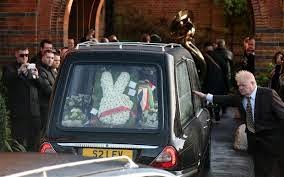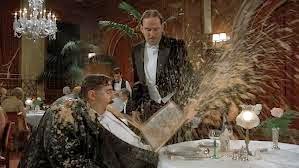"More than 20 years ago I worked for a funeral firm in a big city. I always said I’d write a book about it, that the first sentence would be “You always know it’s a bad one when the copper’s stood outside.” and that the title would be “Confessions off an Undertaker”.
The memories of events that I included are those that have stayed with me; they are even now still extremely vivid, distilled from my experiences by the passage of time and retained in all their immediacy in pin-sharp recall. They are all in various ways remarkable by normal standards of existence, but not at all strange in the world they are part of.
But this turned out to be much more than a collection of stories about undertaking.
The firm I worked for no longer exists (but I have changed the names to protect the innocent - and the guilty - nonetheless), and as I interviewed people working in the trade now to check the details, somehow that process spread to include Europe, and then America and Australia.
As interesting facts discovered along the way led to other interesting facts, and brief digressions became whole sections, it expanded from a personal account of what undertakers do, to include their history, and how they came to take over something we used to do for ourselves, the science and ecology of death today, and the future of how we deal with the dead."
Over Your Dead Body looks at what happens when we die, and what happens afterwards, down the ages. I think the most interesting part is the final section, which is about the new technologies set to replace burial and cremation.
I’ve written it so that it works as something you read from start to finish, but also as something you can dip in and out of wherever you like.
It begins by giving you an idea what it's like to deal with the dead day to day.
Here's the first few pages:
I
A Day in the Life
“You always know it’s a bad one when the copper’s stood outside.” (instead of sat inside having a read of The Sun).
It was a flat above a shop, with very steep stairs right behind the front door, and the flies started as soon as you got in. Upstairs they were so bad that they were crawling up your nose and in your mouth. The smell was atrocious, the kind that gets in your hair and clothes, and that you can’t wash off.
The room was knee-deep in empty beercans, so it was difficult to get through the door, and the cloud of flies was so dense it was difficult to see across the room. Somewhere in there was what the technician at St Dunstan’s called a jolly green giant.
I won’t go into the details of getting it out – we had to use a shell instead of the stretcher. It made you think, though. It was a woman, probably middle-aged from the amount of flesh on her (old people are, as you may have noticed yourself, usually skinny; handy in this line of business). You can’t tell from the clothes - counterfeit designer sports gear is a uniform that transcends age among the drinking classes in that part of town.
Had she got a final stock of booze in, put it to hand, and buried herself in a drift of White Diamond as she drank herself to death? Or was this some kind of interior decoration quirk? I’ve noticed teenagers like to blu-tack cans or beermats to their walls, girls as well as boys, these days.
Jobs like that stand out, of course, but really they’re all extraordinary, because working in the funeral business, you’re involved in something that no-one knows about and no-one talks about.
Death is, as they say, the last taboo – but the endlessly repeated corollary to that endlessly repeated cliché, that death is for us what sex was to the Victorians, is not quite true.
Everyone, even Victorians, thinks about sex, and most have personal experience of it on a regular basis, but death now really is kept out of sight and, if not out of mind, as much as possible physically separated from life.
It seems ironic now, but I took the job because I thought I’d get funny stories out of it. A friend of mine had worked as an embalmer when he was a medical student, and according to him it was one long round of pranks and practical jokes from day one:
Two bearers eyeing a body and a coffin, shaking their heads and saying repeatedly to a new recruit
“’E won’t go in there, oh no, ... E’ll never go in there …”,
then, finally,
“SO WE’LL ‘AVE TO PUT ‘IM IN!”
They told me at the Job Centre that they didn’t get many adverts from undertakers, and that this one specified previous experience essential.
That was a load of bollocks, and I could have spared myself the effort of inventing a past as a casual bearer in another time and another place, because after they’d hired me it dawned on them that everyone else there was a midget compared to me (I’m six foot one). Which made the bearing very undignified, not to say precarious, my shoulder being about 8 inches higher than the other three under the coffin.
You’d think they might have thought of that beforehand. Anyway, after that they got in a young lad who didn’t even pretend to any previous, who turned out to be what I can only describe as a ghoul.
Tim was a gangling streak of piss with prominent knobbly joints and a prominent knobbly adam’s apple and a bad haircut. I suspect he may have even have been ESN, and I certainly had plenty of time to investigate that suspicion, because of course they paired him up with me.
It didn’t help with the bearing, though. What happened was that the coffin took a pronounced foot-down attitude (the head is always at the back) and almost the entire weight was thrown onto the two at the front, which didn’t make me and Tim very popular, however much we pointed out it wasn’t our fault.
Having us at the front was out of the question. Experiment proved that aside from looking even more absurd, the centre of gravity being nearer the back meant that the coffin slid in that direction uncontrollably as soon as we set off.
We were forced to adopt a peculiar gliding walk with our knees bent and our backs crouched. This, coupled with the fact that professional bearers walk with hands clasped in front (not gripping the other side of the coffin, except going up or down steps, at least at funerals), made us look like Uriah Heep in stereo.
On his first day I was called into the boss’s office, introduced to the lad, and was told they’d hired him because he was the same height as me.
“And you’ll be taking him out and showing him the ropes.”
I’d only been there a month or two, and I was passing on the torch of knowledge as it had been passed to me, like a baton in a relay race. A torch that was burning dimly, my instructor having had no great enthusiasm for the job, and me even less.
I was down to drive the van all day, so no funerals, just shuttling bodies to and fro, from shops to and from embalming. Which might be why I’d been landed with him – you don’t want someone who’s never done the job before on a funeral straight off.
I waited while he was given a second-hand polyester suit that didn’t fit, a mac whose sleeves were three inches too short, and a pair of black leather gloves from the wardrobes in what was obviously once a bedroom, presumably when this was the family home above the shop.
Hand in glove in glove
Tim liked the gloves. When we were sat in the van later, him proudly stroking the sleeves of his uniform as if it was from Savile Row, I watched as he took some disposable latex gloves from the box on top of the dashboard and then put them on over the leather ones that he was already wearing, so that his hands looked like packets of cling-wrapped dates.
I looked at him, baffled, while he grinned shyly.
“What have you done that for?”
“I dunno. It feels good.”
We had just collected a body from the downstairs back room and put it on the van (for some reason bodies are always put ‘on’ the van, not ‘in’). I got the impression he was fulfilling a long-held ambition when he first handled a body. It was, predictably, someone’s grandad, the funeral business’s number one customer. Men are supposed to die before their wives because they’re worn out by a life of work and stress. I think it’s just genetic – men’s bodies wear out quicker. I bet that man’s wife had just as hard a (pre-welfare state working class) life as he did.
Tim had had an almost touching look of childlike wonder on his face as he prodded the body’s flesh and manipulated its hands.
“It’s not what I thought at all. It’s all soft and floppy like a big white rubber doll.”
A big cold white rubber doll. At least this one was dressed and ready to go. On my first day I had been sent into the same downstairs back room with a big carrier bag full of clothes that I’d been told to put on someone’s grandad.
I was quite sure that this was the first of that endless round of pranks and practical jokes that I was expecting. After all, I’d read ‘The Loved One’ and ‘The American Way of Death’, so I knew they had special shirts and suits that had a slit up the back for dressing corpses in their coffins.
My new oppo, Dave, tasked with showing me the ropes, in the same way that I would be with Tim, leaned against the wall smoking a roll-up and looking out of the window. I looked in the bag. Everything was in there, all neatly folded: shoes & socks, a three-piece suit, shirt & tie, even singlet & Y-fronts and, on top of the pile, a hankie. He won’t be wiping his nose where he’s going, I thought.
“Is this an open–coffin job, then?” I said, trying to go along with the joke.
Dave shrugged and stared at a bit of tobacco he’d just picked off his lip. After a bit of waiting for him to laugh and say “Gotcha!”, I tried again.
“But this is a joke isn’t it? I don’t really have to dress him up in this lot do I? Who’s going to see it?”
Dave shrugged again and said nothing. At that point Maurice, the head of the firm, who’d just given me the bag upstairs in his office, stuck his head round the door. He’d obviously been listening.
“Something wrong, Bob?”
I wasn’t sure how to play this – if it was a joke, then the boss was in on it.
“Do you really want me to put these clothes on him? Aren’t there special suits for this that fasten up the back?”
But Maurice obviously hadn’t read Evelyn Waugh or Jessica Mitford.
“This is someone’s grandad, Bob. The family have given us these clothes because they want him to be buried in them.”
“So do I cut them up the back to get them on?”
Maurice frowned, and looked at me as if he wasn’t sure if I was trying to wind him up.
“No. They want him to be wearing these clothes, so that’s what he’ll be wearing, not a load of rags.”
I realised it wasn’t a good idea to point out that unless they opened the coffin and took him out to look round the back, there was no way they could know.
“Ah, I see. Right, okay then.”
Maurice gave me a long hard look, then left. I heard him go back upstairs, and realised I hadn’t heard him come down. I got the impression I hadn’t done myself too many favours there.
Grandad was wearing a shirt, cardie, polyester slacks and slippers. Getting those off was hard enough, and Dave made no move to help.
Although this was very obviously the body of an old man in his late 70s with grey hair and a moustache, fit-looking, in an ex-army kind of way, I found I was unable to rid myself of the impression that it was a cunningly-made lifesize wooden doll covered in silicone, or, yes, rubber.
I couldn’t help wondering what kind of job I’d got myself into while I was trying to wrestle the pair of newly-laundered Y-fronts over his wedding tackle. The shoes were surprisingly difficult, too, because his ankles were so floppy, until I stopped trying to hold his ankle and worked out that I had to cup his heel in one hand and cram the shoe on with the other.
I realised I’d been trying to use the same technique as you would with a child, who, however unhelpful, has ankles that don’t wobble all over the place.
Which gave me a marketing idea for Clarks. You remember Start Rite shoes for toddlers? Well, they could look after the other end of the market with End Rite – biodegradable and inflammable, with velcro up the back of the heel to get them on, and a clip for morgue toetags.
I was never asked to dress a body again, nor did I hear of any of the other chauffeur bearers being asked to do it. It was normally done, I think, by the embalmers, who also did the make-up."










